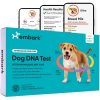Do you know what breed your dog is? Many puppies come with details of their parents, with pedigrees stretching to generations of field trial champions, Crufts stars and so on. But if you acquired your dog from a rescue centre as opposed to a breeder, their heritage may be completely unknown. Around a quarter of a million animals end up in UK rescue centres every year. Fourteen percent of dog owners have rescue dogs, and many of these have unrecorded breeding. Their new owners will naturally be asking themselves, “what breed is my dog?”, and it’s not always straightforward to tell from looks alone.
Most pure-bred puppies have recorded pedigrees. However, plenty of dogs are bred unintentionally, when a bitch on heat goes visiting an unknown local dog, resulting in some surprising mixes. My childhood springer spaniel bitch, Scamp, “married” the Dalmatian up the road, and produced some very bouncy and over-sized pups with large, splodgy spots.
Satisfying curiosity is not the only motivation for wanting to know what breed your dog is. Certain breeds are more prone to particular diseases and conditions, such as diabetes or arthritis, or sensitivity to some drugs, and it’s helpful to know this as you may be able to avoid it by diet, supplements or exercise. Some breeds are more likely to have certain behavioural tendencies, and again, being aware of their genetic make-up can be useful in knowing how to train them, or seeking support from a trainer who specialises in and is sympathetic to that breed. Forewarned is forearmed.
The only way to find out for sure is to use a DNA test. Of course, there are certain physical attributes that can point to dogs being of a particular breed. With pure-bred dogs, this is a lot easier. Most of the time, vets, trainers and knowledgable doggy people will be able to ascertain a pure-breed. But mixed-breed dogs tend to inherit physical traits from both parents – sometimes more from one than the other, which makes it hard to tell. Sometimes such a mating results in surprising offspring.
There are behavioural traits that are innate to particular breeds, which can give some clues. For example, the Basenji barks very little, if at all; Viszlas are known as Velcro dogs due to their propensity to stick close to their handler; while collies naturally enjoy rounding up their herds, whether that’s other pets or small children.
3 ways to find out what breed your dog is
1. DNA testing
Genetic testing is the most reliable way to find out your mixed-breed dog’s heritage. Small genetic differences are associated with specific breeds, enabling the test to pinpoint which ones are involved in your dog’s genetic make-up. The most popular and best DNA test kits for dogs are Wisdom Panel (which is available direct or via Amazon) and Embark, (which is also available direct or via Amazon). One of the most popular human DNA test companies has now also released DNA testing for dogs – Ancestry (which is available direct or via Amazon).
Wisdom Panel has been developed by vets. You swab the dog, and mail the sample to the lab, who screen it against the their database (the world’s largest) to ensure the most accurate results. They have genotyped more than 4 million dogs over 20-plus years of research and genotyping, and claim to “screen for over 23% more dog breeds than leading competitors”.

Wisdom Panel DNA collection kit | Amazon.co.uk
This kit gives you everything you need to collect your dogs DNA and send it off, including a pre-paid envelope if you’re in the UK.
Meanwhile Embark, which also uses the at-home swab and send to lab method, tests over 220,000 genetic markers, “twice as many as the next competitor”. It tests for more than 215 health risks to help you make the best decisions for your dog according to its DNA. They screen for 350-plus dog breeds, “more than any other dog DNA test”. Suffice it to say that both DNA tests are market leaders.
Another industry leader is Orivet DNA test (available on Amazon), which tests for over 350 breeds and varieties of dog. It also gives a personalised wellness plan based on the dog breeds discovered.

Orivet DNA test kit | Amazon.co.uk
This test screens for more than 350 breeds and varieties of canine, and you’ll receive your results in just two to three weeks.
Ancestry is one of the leading human genealogy websites and it now has released a DNA testing kit for your dog. It can help you identify your dog’s breed, but will also let you know about close genetic matches.

Ancestry Pet DNA kit | Amazon.co.uk
This test kit looks for more than 30 unique characteristics that your dog has inherited from their unique mixture of ancestors.
2. Apps
Just as you can identify a mushroom, tree or flower, so you can download an app, upload a photo or video and AI will determine which breed is most closely allied to your dog. While this can be fairly accurate for pedigree dogs, the technology is not yet intelligent enough to work out mixed breeds with great reliability. However, it could give you a fair idea of the breeds involved. You can try the Dog Scanner (from the Google Play Store or the Apple Store), which identifies more than 370 different breeds, or DogSnap (available on Apple), which apparently recognises “more than 600 kinds of dog”.
3. Online quiz
If you are just after a bit of fun, try an online quiz. You go through a series of questions that will guide you towards the breeds most closely resembling your dog. Mixed breeds are even harder to identify by this method but it might help you narrow down the options.
Some of these quizzes are more cute than accurate – answering questions for my pure-bred springer spaniel came out as a Pomeranian or a bulldog. Try the “what breed is my mutt” quiz for a laugh, or for a more serious version, the Dog Key’s quiz, in which the spaniel came out more convincingly as having “gundog ancestry”.
What breed would you guess this dog is?

It’s an American Staffie/lurcher (the latter itself not being a breed but a type of dog, resulting from a sighthound crossed with a collie or a terrier) – who required a DNA test to determine his genetic make-up. What a beauty!
You may also enjoy reading…

21 of the cutest dog breeds to make you coo, smile (and want more dogs…)

Who’s a clever dog? The 7 smartest dog breeds in the world

Meet 7 of the world’s smallest dog breeds

Meet 7 of the largest dog breeds on the planet

10 of the most expensive dog breeds in the world – how does your pooch measure up?

Subscribe to Horse & Hound magazine today – and enjoy unlimited website access all year round
Horse & Hound magazine, out every Thursday, is packed with all the latest news and reports, as well as interviews, specials, nostalgia, vet and training advice. Find how you can enjoy the magazine delivered to your door every week, plus options to upgrade your subscription to access our online service that brings you breaking news and reports as well as other benefits.






